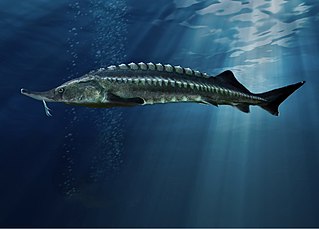
Penguins are a group of aquatic flightless birds. They live almost exclusively in the Southern Hemisphere, with only one species, the Galápagos penguin, found north of the Equator. Highly adapted for life in the water, penguins have countershaded dark and white plumage and flippers for swimming. Most penguins feed on krill, fish, squid and other forms of sea life which they catch while swimming underwater. They spend roughly half of their lives on land and the other half in the sea.

The International Union for Conservation of Nature (IUCN) Red List of Threatened Species, founded in 1964, is the world's most comprehensive inventory of the global conservation status of biological species. It uses a set of criteria to evaluate the extinction risk of thousands of species and subspecies. These criteria are relevant to all species and all regions of the world. With its strong scientific base, the IUCN Red List is recognized as the most authoritative guide to the status of biological diversity. A series of Regional Red Lists are produced by countries or organizations, which assess the risk of extinction to species within a political management unit.

Threatened Species are any species which are vulnerable to endangerment in the near future. Species that are threatened are sometimes characterised by the population dynamics measure of critical depensation, a mathematical measure of biomass related to population growth rate. This quantitative metric is one method of evaluating the degree of endangerment.

The Monimiaceae is a family of flowering plants in the magnoliid order Laurales. It is closely related to the families Hernandiaceae and Lauraceae. It consists of shrubs, small trees, and a few lianas of the tropics and subtropics, mostly in the southern hemisphere. The largest center of diversity is New Guinea, with about 75 species. Lesser centres of diversity are Madagascar, Australia, and the neotropics. Africa has one species, Xymalos monospora, as does Southern Chile. Several species are distributed through Malesia and the southwest Pacific.

The conservation status of a group of organisms indicates whether the group still exists and how likely the group is to become extinct in the near future. Many factors are taken into account when assessing conservation status: not simply the number of individuals remaining, but the overall increase or decrease in the population over time, breeding success rates, and known threats. Various systems of conservation status exist and are in use at international, multi-country, national and local levels as well as for consumer use.

A least-concern species is a species that has been categorized by the International Union for Conservation of Nature (IUCN) as evaluated as not being a focus of species conservation. They do not qualify as threatened, near threatened, or conservation dependent.

A near-threatened species is a species which has been categorized as "Near Threatened" (NT) by the International Union for Conservation of Nature as that may be considered threatened with extinction in the near future, although it does not currently qualify for the threatened status.

An IUCN Red List Critically Endangered (CR) species is one that has been categorized by the International Union for Conservation of Nature as facing an extremely high risk of extinction in the wild. As of 2021, there are 6,811 species that are considered to be Critically Endangered. This is out of the 120,372 species currently tracked by the IUCN.

Mollinedia is a genus of flowering plants in the family Monimiaceae. There are about 90 species distributed in the forests of the Neotropics. They are mainly shrubs and trees.
Mollinedia butleriana is a species of plant in the Monimiaceae family. It is endemic to Honduras.
Mollinedia engleriana is a species of plant in the Monimiaceae family. It is endemic to Brazil.
Mollinedia gilgiana is a species of plant in the Monimiaceae family. The plant is endemic to the Atlantic Forest ecoregion in southeastern Brazil. It is a Critically endangered species, threatened by habitat loss.
Mollinedia glabra is a species of plant in the Monimiaceae family. It is endemic to Brazil. It is threatened by habitat loss.
Mollinedia longicuspidata is a species of plant in the Monimiaceae family. It is endemic to Brazil.
Mollinedia marquetiana is a species of plant in the Monimiaceae family. It is endemic to Brazil. It is threatened by habitat loss.
Mollinedia ruae is a species of plant in the Monimiaceae family. It is found in Honduras and Nicaragua.
Mollinedia stenophylla is a species of plant in the Monimiaceae family. It is endemic to Brazil. It is threatened by habitat loss.

An endangered species is a species that is very likely to become extinct in the near future, either worldwide or in a particular political jurisdiction. Endangered species may be at risk due to factors such as habitat loss, poaching and invasive species. The International Union for Conservation of Nature (IUCN) Red List lists the global conservation status of many species, and various other agencies assess the status of species within particular areas. Many nations have laws that protect conservation-reliant species which, for example, forbid hunting, restrict land development, or create protected areas. Some endangered species are the target of extensive conservation efforts such as captive breeding and habitat restoration.
M. salicifolia may refer to:








